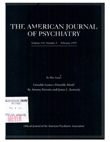A psychodynamic model of panic disorder
Abstract
Current psychiatric research on panic disorder and its treatment are heavily influenced by neurobiological and cognitive-behavioral models rather than psychodynamic propositions, and psychodynamic treatment is generally considered to be of little benefit in amelioration of symptoms. However, because neither of the current models fully explains the clinical psychopathology, etiology, or pathogenesis of panic disorder, there is a need for further model building. The authors suggest that a psychodynamic approach may add to the understanding of patients with panic disorder. They base their psychodynamic formulation on pilot interviews with nine patients with panic disorder, published reports of psychological characteristics of patients with panic disorder, and data from infant and animal research on temperament. Interview results included the following: 1) all of the patients described themselves as fearful, nervous, or shy as children, 2) they remembered their parents as angry, frightening, critical, or controlling, 3) they frequently indicated discomfort with aggression, 4) most described chronic feelings of low self-esteem, 5) their spouses were characterized as passive, kind, and nonaggressive, and 6) stressors associated with frustration and resentment preceded the onset of panic. The authors propose a model in which inborn neurophysiological irritability predisposes to early fearfulness. Exposure to parental behaviors that augment fearfulness results in disturbances in object relations and persistence of conflicts between dependence and independence, which predispose to fears of feeling trapped, suffocated, and unable to escape and/or feeling alone and unable to get help. Catastrophic fears of helplessness in the face of suffocation or abandonment are easily accessible.(ABSTRACT TRUNCATED AT 250 WORDS)
Access content
To read the fulltext, please use one of the options below to sign in or purchase access.- Personal login
- Institutional Login
- Sign in via OpenAthens
- Register for access
-
Please login/register if you wish to pair your device and check access availability.
Not a subscriber?
PsychiatryOnline subscription options offer access to the DSM-5 library, books, journals, CME, and patient resources. This all-in-one virtual library provides psychiatrists and mental health professionals with key resources for diagnosis, treatment, research, and professional development.
Need more help? PsychiatryOnline Customer Service may be reached by emailing [email protected] or by calling 800-368-5777 (in the U.S.) or 703-907-7322 (outside the U.S.).



